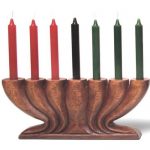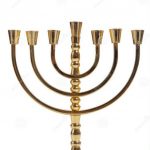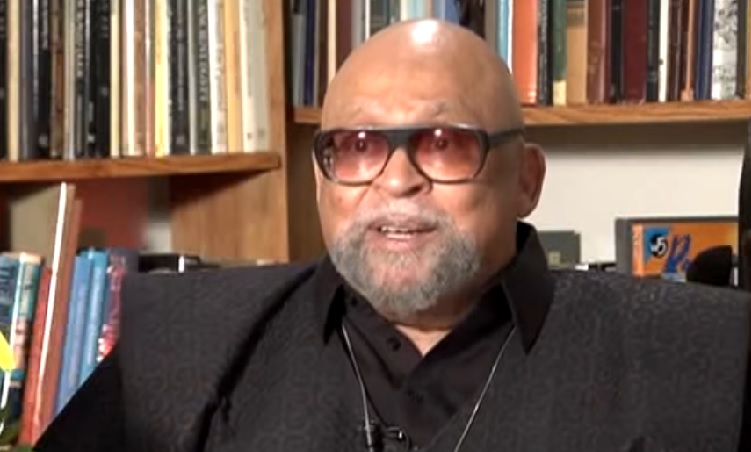About the founder of Kwanzaa: “A sentencing hearing transcript shows that the unidentified psychiatrist believed that the founder of Kwanzaa was “both paranoid and schizophrenic.”
Matthew 15:7-9 “Ye hypocrites, well did Esaias prophesy of you, saying, 8 This people draweth nigh unto me with their mouth, and honoureth me with their lips; but their heart is far from me.9 But in vain they do worship me, teaching for doctrines the commandments of men.“
The Kwanzaa Celebration
Families celebrating Kwanzaa decorate their households with objects of art, colorful African cloth such as kente, especially the wearing of kaftans by women, and fresh fruits that represent African idealism. It is customary to include children in Kwanzaa ceremonies and to give respect and gratitude to ancestors…..
A Kwanzaa ceremony may include drumming and musical selections, libations, a reading of the African Pledge and the Principles of Blackness, reflection on the Pan-African colors, a discussion of the African principle of the day or a chapter in African history, a candle-lighting ritual, artistic performance, and, finally, a feast (karamu). Source: Wikipedia
Drumming: Any person that has come out of African Witchcraft, Voodoo or any such false religion, will tell you the beating of the drums is done to conjure up spirits, demons, that will then possess the participants!
Libation: A libation is a ritual pouring of a liquid, or grains such as rice, as an offering to a god or spirit, or in memory of those who have “passed on”. It was common in many religions of antiquity and continues to be offered in various cultures today. Source: Wikipedia
The Candle Lighting Ritual
Seven candles in a kinara symbolize the seven principles of Kwanzaa. It is NOT Biblical in anyway and in fact, I believe it is a direct Mockery of the Menorah that was required to be kept lit in the Tabernacle, and the Holy of Holies in the Temple!!

 If you will please note in the image comparison, The candle in the center of the Kinara represents a Black person, and in this case as you will read later, I believe the founder of Kwanzaa has set himself as the center candle. His name does mean “master teacher”!
If you will please note in the image comparison, The candle in the center of the Kinara represents a Black person, and in this case as you will read later, I believe the founder of Kwanzaa has set himself as the center candle. His name does mean “master teacher”!
In the Menorah, the center candle, or lamp as it is called in the Bible, represents Jesus Christ our Lord and Savior! Traditional Jews won’t tell you it symbolizes Jesus, but the Whole of the Bible IS about Jesus in types and shadows! Do you see the twisting and deception!
Got Questions – The menorah is a lamp stand with longstanding tradition in both the Bible and the history of Judaism. The word itself is a transliteration of a Hebrew word. It was first mentioned in Exodus 25:31-39:
“And thou shalt make a candlestick of pure gold: of beaten work shall the candlestick be made: his shaft, and his branches, his bowls, his knops, and his flowers, shall be of the same. 32 And six branches shall come out of the sides of it; three branches of the candlestick out of the one side, and three branches of the candlestick out of the other side: 33 Three bowls made like unto almonds, with a knop and a flower in one branch; and three bowls made like almonds in the other branch, with a knop and a flower: so in the six branches that come out of the candlestick. 34 And in the candlestick shall be four bowls made like unto almonds, with their knops and their flowers. 35 And there shall be a knop under two branches of the same, and a knop under two branches of the same, and a knop under two branches of the same, according to the six branches that proceed out of the candlestick. 36 Their knops and their branches shall be of the same: all it shall be one beaten work of pure gold. 37 And thou shalt make the seven lamps thereof: and they shall light the lamps thereof, that they may give light over against it. 38 And the tongs thereof, and the snuffdishes thereof, shall be of pure gold. 39 Of a talent of pure gold shall he make it, with all these vessels.”
The original menorah was designed for use in the tabernacle in the wilderness before Israel entered the Promised Land. After the conquest of Canaan, it remained in the tabernacle (Joshua 18:1) and was later used in the temple Solomon built.
The design of the menorah was quite significant. It included a shaft complemented with three branches on each side; thus, it held a total of seven lamps. Each cup included an intricate design. The menorah was made of one piece of hammered gold weighing one talent. Scholars debate the exact weight of a “talent of pure gold.” First-century Jewish historian Josephus said that the menorah in his time was approximately 100 pounds. If this was the size of the talent used in Exodus, it would represent an enormous sum of money. To give a general idea, 1 gram of gold is currently worth about $57.35. One hundred pounds of gold would be worth $2,603,690.00. Certainly, in any period of history, a talent of gold would have had tremendous value. One commentator mentions a talent of gold as worth 20 years’ wages for a common laborer in the first century.
According to the Mosaic Law, the menorah was lit every evening and cleaned every morning (Exodus 27:21). It burned fresh olive oil.
Today, the menorah continues to be one of the best-known symbols of Judaism. It is a common fixture in local synagogues. A nine-candle version is used in association with the Jewish holiday of Hanukah. Additionally, those involved in reconstructing items for a future Jewish temple have made menorahs reflecting the design given to Moses. Source: Got Questions
Is Candle lighting Biblical?
Got Questions – The practice of lighting candles for the dead may or may not have religious connotations. Sometimes, after a tragedy, people hold candlelight vigils or leave lighted candles at the scene of a person’s death. In these contexts the candles could simply be symbols of the brevity of life or pledges of the living to brighten a dark world. There is nothing wrong with lighting candles for such purposes. However, there are some churches that advise people to light candles for the dead, an action usually accompanied by prayers for the dead. This practice is clearly contrary to biblical teachings. Read more at Got Questions
Again, each of the candles have a meaning. The black one symbolizes the African people, the red their struggle, and the green the future and hope that comes from their struggle.
Where is the representation of other people of Color whether they be Brown, Yellow or White!
I have said this in other articles, If you Identify as a Christian, there should be NO SUCH THING as “White church”, “Black church”, “Hispanic church”, “ Catholic church”, “Mormon church”, “Baptist church”, “Pentecostal church” etc., only the Church of the Lord Jesus Christ. Anyone who thinks, preaches, or teaches otherwise is Racist !!!
Got Questions – There is no biblical reason why we can’t light candles while we pray or while we do anything else, for that matter. Candles are inanimate objects. They have no power, no strength, and no mystical or supernatural abilities. They are nothing more than wax and a piece of string with maybe some scent added in.
Note: The Wicca’s will argue that point! To them, and Satan, it is a required item in black magic and spell casting! It is important to know that Satan will take anything in the Word of God and twist it into a perversion that leads a Biblically Ignorant person into sometimes unknowingly worshiping him.
Candles—and other lights such as Christmas decorations—can remind us that Jesus is the Light of the World. Candles can remind us to put our “trust in the Light so that [we] may become sons of Light” (John 12:36). Having a candle burning while we pray might serve to focus our prayers and thoughts on Jesus as the Light of the world.
What candles cannot do, however, is accompany our prayers to heaven, make our prayers more powerful or effective, add anything to our prayers, or pray for us in any way. Candles burning in a Roman Catholic church, for example, are thought to continue the pray-er’s petition long after he/she has left the church. This is unbiblical. Prayer is a conversation with our heavenly Father—a dialogue between two live, conscious, responsive beings who share the same Spirit. No candle can enter into such a relationship.
Candles are used in various types of worship rituals. Witches and shamans, Catholics, new-agers, some Protestants, Jews, Buddhists, and Hindus all use candles in their worship services. Lighting votive candles is also consistent with the emerging worship trends that embrace mystery, mysticism, and entering into reality through experience.
In the end, the use of candles in prayer is innocent in itself. The danger is in ascribing to them a power they simply don’t possess. Source: Got Questions
Again, tell that to the people who are Ignorant. Deep rooted traditions and religious beliefs are the hardest to shine the light on. I suppose that is why Paul said in 2nd Corinthians 4:3-5 “But if our gospel be hid, it is hid to them that are lost: 4 In whom the god of this world hath blinded the minds of them which believe not, lest the light of the glorious gospel of Christ, who is the image of God, should shine unto them. 5 For we preach not ourselves, but Christ Jesus the Lord; and ourselves your servants for Jesus’ sake.”
Kwanzaa celebrates what its founder called the seven principles of Kwanzaa, or Nguzo Saba (originally Nguzu Saba—the seven principles of African Heritage), which Karenga said “is a communitarian African philosophy,” consisting of what Karenga called “the best of African thought and practice in constant exchange with the world.” They were developed in 1965, a year before Kwanzaa itself. These seven principles comprise Kawaida, a Swahili word meaning “common”. Each of the seven days of Kwanzaa is dedicated to one of the following principles, as follows:
- Umoja (Unity): To strive for and to maintain unity in the family, community, nation, and race.
- Kujichagulia (Self-Determination): To define and name ourselves, as well as to create and speak for ourselves.
- Ujima (Collective Work and Responsibility): To build and maintain our community together and make our brothers’ and sisters’ problems our problems and to solve them together.
- Ujamaa (Cooperative Economics): To build and maintain our own stores, shops, and other businesses and to profit from them together.
Nia (Purpose): To make our collective vocation the building and developing of our community in order to restore our people to their traditional greatness. - Kuumba (Creativity): To do always as much as we can, in the way we can, in order to leave our community more beautiful and beneficial than we inherited it.
- Imani (Faith): To believe with all our hearts in our people, our parents, our teachers, our leaders, and the righteousness and victory of our struggle.
Just words that drop to the floor from the mouths who speak them, and have no meaning and and are not worth the paper they are written on! If they did Black on Black crime would not exist and those who hold those words dear would not hate people of other colors! As I have written, Racism needs a Willing Vessel!
Kwanzaa celebratory symbols include a mat (Mkeka) on which other symbols are placed: a Kinara (candle holder), Mishumaa Saba (seven candles), mazao (crops), Muhindi (corn), a Kikombe cha Umoja (unity cup) for commemorating and giving shukrani (thanks) to African Ancestors, and Zawadi (gifts). Supplemental representations include a Nguzo Saba poster, the black, red, and green bendera (flag), and African books and artworks – all to represent values and concepts reflective of African culture and contribution to community building and reinforcement. Corn is the primary symbol for both decoration and celebratory dining. Source: Wikipedia
This crap is nothing more than Racism and Black Liberation Theology nicely packaged in a religious wrapping. Remember that Satan appears as an angel of light!
2nd Corinthians 11:13-15 “For such are false apostles, deceitful workers, transforming themselves into the apostles of Christ. 14 And no marvel; for Satan himself is transformed into an angel of light. 15 Therefore it is no great thing if his ministers also be transformed as the ministers of righteousness; whose end shall be according to their works.”
You might want to read this series about the AME Church, mainly parts 2 and 3!!
AME – Smyrna Church Spirit Alive and Doing Well Part 1 – Planned Parenthood CEO Cecile Richards Stands in Front of a Cross While Promoting Abortion
AME – Smyrna Church Spirit Alive and Doing Well Part 2 – The Ancestral Worship of Black Churches
AME – Smyrna Church Spirit Alive and Doing Well Part 3 – Black Lives Matter Organizer Summons Spirits of Deceased African American Leaders in Methodist Church
The Creator of Kwanzaa is a Criminal Loon who Allegedly Tortured Naked Women with a Karate Baton and a Toaster
Headline and these excerpts are from the Daily Caller. Please Avail yourself and go read the whole article. I did not know anything about Kwanzaa until I read this in my daily news scan at 12:30 AM on Christmas morning 2018! The Lord quickened me to check into it and to warn ignorant people of the Spiritual Dangers involved!
The creator of Kwanzaa is Maulana Ndabezitha Karenga, a 77-year-old professor of Africana studies at California State University, Long Beach. His real name is Ronald Everett. He was born in rural Maryland, the fourteenth child of a sharecropping Baptist minister.
Karenga was convicted in 1971 for brutally torturing two naked women. The weapons of torture included a soldering iron, a vise and, of course, a toaster.
A psychiatrist who examined Karenga in 1971 concluded he was insane. A sentencing hearing transcript shows that the unidentified psychiatrist believed that the founder of Kwanzaa was “both paranoid and schizophrenic.”
Judge Arthur L. Alarcon ordered Karenga to undergo mental testing to determine whether Karenga had “so deteriorated mentally” that he was a threat to society.
The judge read from the psychiatrist’s report in court in September 1971, according to a FrontPage Magazine report.
“Since his admission here he has been isolated and has been exhibiting bizarre behavior, such as staring at the wall, talking to imaginary persons, claiming that he was attacked by dive-bombers and that his attorney was in the next cell,” the psychiatrist’s report said, in part. “During part of the interview, he would look around as if reacting to hallucination and when the examiner walked away for a moment he began a conversation with a blanket located on his bed.”
“This man now presents a picture which can be considered both paranoid and schizophrenic with hallucinations and delusions, inappropriate affect, disorganization, and impaired contact with the environment,” the report said……….
The name change. At some point in the 1960s, Karenga decided he didn’t want to be Ron Everett any longer. Instead, he gave himself the name “Maulana,” which is Swahili for “master teacher.” Karenga means “keeper of tradition” in Swahili.
So he is the “Master Teacher and Keeper of Tradition” of African Witchcraft and Ancestor Worship. Most in Africa would call that a Witch-Doctor!
If you go to the store to buy Meat, don't run to the Milk section or the Junk Food aisle looking for it!!
The Meat Section is the True Gospel of Jesus Christ.
The Milk Section is likened to those who will not preach on sin and Hell, just a feel good message, the Social gospel.
The Junk Food Isle is the outright false doctrine AKA the prosperity gospel, name it and claim it, the Hebraic Roots movement and other false teachings!!
Feasting on just Milk and Junk will eventually cause you great harm, you can count on it!!
If you appreciate what this Ministry is doing to Expose the Fake Christians, Satanists, Witches, Communist/Socialist Democrats, R.I.N.O Republicans and the assault on our Conservative, True Christian values, please consider a small donation to help us continue and expand. This Ministry is not only under attack by the Enemy, we are now under attack from supposed Christians also. It is what Tom Horn calls 'Blood on the Altar"!
